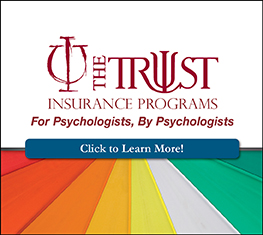The professional home for health service psychologists.
Join a community of 15,000 psychologists and trainees.
Learn it today. Apply it tomorrow.
Connecting you to what you need in your career.
Making a difference.
Eckerd, M. (2018). Identifying Autism Spectrum Disorder (level 1) in adults. Journal of Health Service Psychology, 44, 93–100.
Autistic Spectrum Disorder (ASD) is a neurodevelopmental disorder that is present from childhood. Prevalence rates range from 1% to 1.5%. Males are more likely to be diagnosed with ASD than females. A review of childhood and current behavior and social functioning is critical to accurate diagnosis. Listening to the description of problems from the perspective of the patient, building the treatment alliance, and processing the details of problematic social interactions are essential to successful outcomes. Coaching and role-playing can also be useful techniques.
Registrants can read the full article on CE.NationalRegister.org.
Alhanai, Tuka and Ghassemi, Mohammad Mahdi. (2017). Predicting Latent Narrative Mood
Audio and Physiologic Data. Proceedings of the Thirty-First AAAI Conference on Artificial Intelligence (AAAI-17). Massachusetts Institute of Technology, Cambridge MA
Alison, C., Auyeung, V, and Baron-Cohen, S. (2012). Toward Brief Red Flags For Autism Screening: The Short Autism Spectrum Quotient and the Short Quantitative Checklist For Autism in Toddlers in 1,000 Cases and 3,000 Controls. Journal American Academy of Child and Adolescent Psychiatry, 5!, 202-211
Anagnostou, E., Zwaigerbaum, L., Scatmari, P, Fombonne, E., Fernandez, B, Woodbury-Smith, M, Brian, J., Bryson, S., Smith, I., Drmic, I., Buchanan, J., Roberts, W., and Scherer, S. (2014) Autism Spectrum Disorder: AdvancesiIn Evidence-Based Practice, CMAJ-JAMC, 186, 509-519
Aston, M. (2003) Aspergers In Love . Jessica Kingsley Publishers: London, U.K. and Philadelphia, PA.
Attwood, T, Evans, C & Lesco, A. (Editors). (2014). Been There. Done That. Try This! An Aspie’s Guide to Life On Earth. Jessica Kingsley Publishers London, U.K. and Philadelphia, PA)
Baghdadli, A., Russet, F, Mottron, L. ( 2017). Measurment Properties of Screening and Diagnostic Tools For Autsim Spectrum Adults of Mean Normal Intelligence: A Systematic Review. European Psychiatry 44, 104-124
Baron-Cohen, S., Wheelwright, S., Robinson, J., &Woodbury-Smith, M. (2005). The Adult Asperger Assessment (AAA): A Diagnostic Method Journal of Autism and Developmental Disorders DOI 10.1007/s1083-005-0026-5
Bentley, K. (2007). Alone Together: Making an Asperger Marriage Work. Jessica Kingsley Publishers: London U.K and Philadelphia, PA
Bissonnette, B. (2013). Asperger’s Syndrome Workplace Survival Guide. Jessica Kingsley Publishers: London U.K and Philadelphia, PA
Bissonnette, B. (2013). The Complete Guide to Getting A Job for People With Asperger’s Syndrome: Find the Right Career and Get Hired. Jessica Kingsley Publishers: London U.K and Philadelphia, PA
Center for Disease Control. (2014). Prevalence of Autism Spectrum Disorder Among Children Aged 8 Years – Autism and Developmental Disabilities Monitoring Network, 11 Sites, US https://www.cdc.gove/mmwr/volumes/67/ss/ss6706a1.htm
Craft, S . (2016). Everyday Aspergers Booklogix: Alpharetta, GA
Gaus, Valerie. (2017). Cognitive Behavioral Therapy For Asperger Syndrome .Guilford Press: New York, NY
Gutstein, S., & Sheely, R. (2002). Relationship Development Intervention with Children, Adolescents and Adults: Social and Emotional Development Activities for Asperger’s Syndrome, Autism, PDD and NLD. Jessica Kingsley Publishers: London, UK and Philadelphia, PA.
Fridrich, E., Sivanathan, A., Lim, T, Suttle, N., Louchart, S., Pillen, S, Pineda, J. (2015). An Effective Neurofeedback Intervention to Improve Social Interactions in Children with Autism Spectrum Disorder J Autism Developmental Development, 45, 4084-4100. DOI 10.1007/10803-015-2523-5
Loomes, R., Hull, L., Polmear, L, Mandy, D. (2017). What is The Male-To-Female Ratio in Autism Spectrum Disorder? A Systematic Review and Meta-Analysis. Journal of The American Academy of Child and Adolescent Psychiatry 56, 466-474.
Mazurek, M. (2013). Social Media Use Among Adults with Autism Spectrum Disorders Computers in Human Behavior 29, 4: 1709-1714.
Pilling, S., Baron-Cohen, S., Megnin-Vigars, O., Lee, R., & Taylor, C. (2012). Recognition, Referral, Diagnosis and Management of Adults with Autism: Summary of NICE Guidance. BMJ, 34, 344-e4082. doi 10.1136/bmj.e4082
Primack, B., Shensa, A., Sidani, J., Whaite, E., Lin, L., Rosen, D., Colditz, J., Radovic, A., Miller, E. (2017). Social Media Use and Perceived Social Isolation Among Young Adults in the U.S. American Journal of Preventive Medicine 53 (1) 1-8.
Robison, John Elder. (2016). Switched On: A Memoir of Brain Change and Emotional Awakening. Spiegel & Grau: New York, NY
Ed: Scarpa, A., White, S., Attwood, T. (2013). CBT For Children and Adolescents with High Functioning Autism Spectrum Disorders. Guilford Press: New York, N.Y.
Takara, K, Tsuyoshi, K, Kuba, T. (2015). How and Why is Autism Spectrum Disorder Misdiagnosed in Adult Patients – From Diagnostic Problem to Management for Adjustment. Mental Health in Family Medicine, 11, 73-88.
Thompson, L., Thompson, M, Reid, A. (2010). Neurofeedback Outcomes in Clients with Asperger’s Syndrome. Applied Psychophysiology and Biofeedback, 35, 63-81.
Ward, D., Dill-Shackleford, K., Mazurek, M. (2018). Cyberpsychology, Behavior and Social Networking, 21 (3): 205-209
Winner, M & Crooke, P. (2016). When Good Intentions Are Not Good Enough. Social Thinking Publishing: Santa Clara, CA
Copyright © 2025 All rights reserved. National Register of Health Service Psychologists







